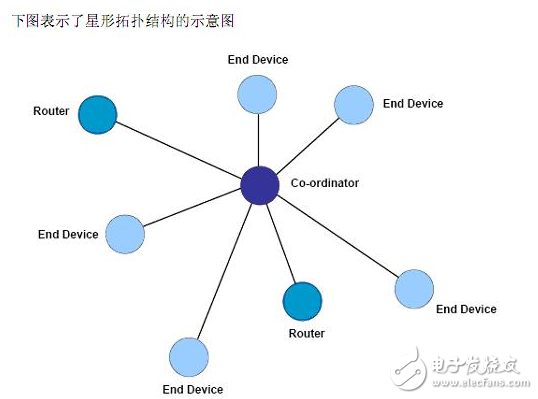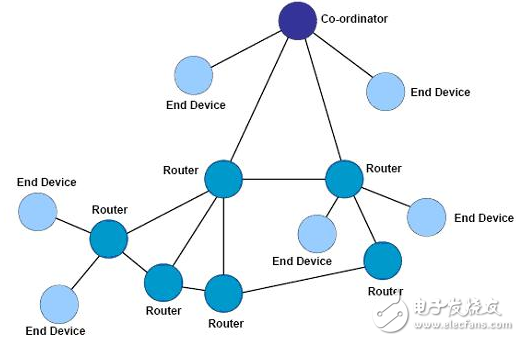As a short-range, low-power, low-data-rate wireless network technology, zigbee is a technology solution between wireless tag technology and Bluetooth. It is widely used in sensor networks and other fields, thanks to its powerful The networking capabilities can form three zigbee networks: star, tree and mesh. You can choose the appropriate zigbee network structure according to the actual project needs. The three zigbee network structures have their own advantages. The star topology is the simplest form of topology. It consists of a Co-ordinator node and a series of End Device nodes. Each End Device node can only communicate with the Co-ordinator node. If you need to communicate between two End Device nodes, you must forward the information through the Co-ordinator node. The disadvantage of this topology is that there is only one path to the data route between nodes. Co-ordinator (coordinator) has the potential to become a bottleneck for the entire network. Implementing a star network topology does not require the use of zigbee's network layer protocol, since the IEEE 802.15.4 protocol layer itself has implemented a star topology, but this requires developers to do more work at the application layer, including processing information themselves. Forwarding. The tree topology includes a Co-ordinator and a series of Router and End Device nodes. The Co-ordinator connects a series of Routers and End Devices, and the routers of its child nodes can also connect to a series of Routers and End Devices. This can repeat multiple levels. The structure of the tree topology is shown below: have to be aware of is: Co-ordinator and Router nodes can contain their own child nodes. End Device cannot have its own child nodes. a node with the same parent node is called a sibling node a cousin node between nodes with the same grandparent node Communication rules in a tree topology: Each node can only communicate with its parent and child nodes. If you need to send data from one node to another, the information is passed up the path of the tree to the nearest ancestor node and then down to the target node. The disadvantage of this topology is that the information has only a single routing channel. In addition, the routing of information is handled by the protocol stack layer, and the entire routing process is completely transparent to the application layer. The Mesh topology (mesh topology) consists of a Co-ordinator and a series of Router and End Device. This network topology is the same as the tree topology; please refer to the tree network topology mentioned above. However, the mesh network topology has more flexible information routing rules, and direct communication between routing nodes is possible when possible. This routing mechanism makes information communication more efficient, and means that once a routing path has a problem, the information can be automatically transmitted along other routing paths. A schematic diagram of the mesh topology is as follows: Usually, in support of the implementation of the mesh network, the network layer provides a corresponding route discovery function, which enables the network layer to find an optimized path for information transmission. It should be noted that the above mentioned features are implemented by the network layer, and the application layer does not need any participation. The network of the MESH mesh network topology has powerful functions. The network can communicate by means of “multi-level hoppingâ€; the topology can also form an extremely complex network; the network also has self-organizing and self-healing functions; Star and family tree networks are suitable for applications with many points and relatively close distances. Industrial Energy Storage System The main function of the Industrial Energy Storage System is to store energy in the industrial field to meet the energy demand in the industrial production process. It is an energy storage solution for improving energy efficiency and power supply stability in industrial production systems. large scale battery energy storage systems, utility scale battery energy storage systems, electrical energy storage systems, commercial and industrial energy storage, energy storage system company Ningbo Autrends International Trade Co., Ltd. , https://www.aitsolarpanels.com


Main effect:
Energy peak shaving: Industrial energy storage systems can store energy and release energy at the peak of energy demand to meet the high energy consumption demand in the industrial production process. This helps to achieve a balanced deployment of energy and avoid energy waste or power outages caused by imbalances in energy supply and demand.
Reserve power supply: When the power supply of the power grid is unstable or there is a power outage, the industrial energy storage system can be used as a backup power supply to continue to supply the power required by industrial equipment and ensure the continuous operation of industrial production.
Energy saving and emission reduction: Through rational use of energy storage, industrial energy storage systems can optimize energy consumption and reduce energy waste, thereby achieving the goal of energy saving and emission reduction, and reducing the impact of industrial production on the environment.
Differences from other energy storage systems:
Scale and capacity: Industrial energy storage systems usually have large scale and energy storage capacity to meet the high energy demand in industrial production. Home energy storage systems, on the other hand, are usually smaller and are mainly used in home photovoltaic power generation systems.
Application scenarios: Industrial energy storage systems are mainly used in the industrial field to meet the energy demand in the industrial production process. The Home Energy Storage System is used in the home photovoltaic power generation system to improve the energy self-sufficiency of the home.
Control and management: Due to the large scale of industrial energy storage systems, their control and management require more complex and precise technical means to achieve efficient energy utilization and stable supply. Home energy storage systems are usually relatively simple and easier to automate and manage.
Generally speaking, the main function of industrial energy storage systems is to meet the energy demand in the process of industrial production, realize the balanced deployment of energy, and the stability of the power supply. Compared with home energy storage systems, it is different in terms of scale, capacity, application scenarios, and technical complexity. The application of industrial energy storage systems helps to improve the energy utilization efficiency of industrial production, optimize energy management, and promote sustainable development and green production.